Mastering Authentic Instant Pot Ramen: Crafting Rich Broth with Pork Hock or Spareribs
Embark on a delightful culinary adventure to create the ultimate Japanese ramen in the comfort of your own kitchen, effortlessly using a pressure cooker or Instant Pot. This comprehensive guide will illuminate the path to crafting intensely flavorful ramen noodle soup, brimming with rich textures and aromatic depth, all accomplished in a mere fraction of the traditional simmering time. We’ll delve into two distinct yet equally delicious broth options: one steeped in the succulent essence of pork hock and another built upon the versatile and readily available pork spareribs, empowering you to tailor your perfect bowl to your preferences and available ingredients.
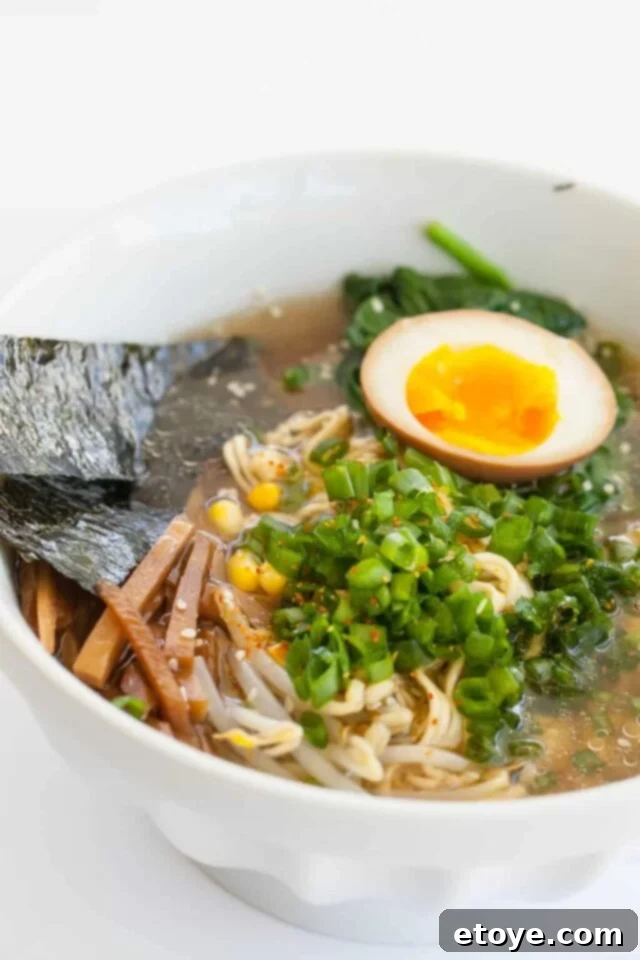
Why This Instant Pot Ramen Recipe Stands Out from the Rest
Crafting truly authentic ramen broth traditionally demands hours, sometimes even an entire day, of slow, patient simmering to extract every last nuance of flavor and precious collagen from the bones. This dedication is what gives traditional ramen its legendary depth. However, with the ingenious application of an electric pressure cooker, we can now achieve remarkably similar depths and complexities in a significantly shorter timeframe. Our Instant Pot Ramen recipe isn’t merely about accelerating the process; it’s about smart cooking that consistently delivers exceptional results without compromising on the robust taste or luxurious texture that defines great ramen.
- A Speedy Shortcut to Classic Ramen Soup: Bid farewell to all-day kitchen commitments. Your Instant Pot ingeniously transforms the laborious hours of traditional broth making into a remarkably efficient 90-minute pressure cooking cycle. This means deeply flavored, authentic ramen is now within reach, even on your busiest weeknights.
- Accessible and Everyday Ingredients: We prioritize ingredients that are widely available at most mainstream grocery stores. You won’t need to embark on a quest for obscure or hard-to-find items to achieve the genuine, savory notes that characterize authentic Japanese flavors.
- Customizable Protein Foundations: Whether your palate yearns for the profound, gelatinous richness derived from pork hock or you prefer the more common, yet equally delicious, pork spareribs, this recipe offers flexible options. This adaptability ensures you can create your ideal ramen based on both personal preference and ingredient accessibility.
- A Lighter Yet Exceptionally Full-Flavored Broth: While the esteemed traditional tonkotsu ramen is often known for its considerable fat content, our refined method aims for a noticeably less oily broth. Through the critical step of parboiling the bones and carefully skimming any excess fat, we successfully achieve a clean, delicate mouthfeel. Crucially, this is accomplished without sacrificing any of the robust, deeply savory flavors that are the hallmark of an outstanding ramen broth.
The Heart of the Bowl: Essential Ingredients for Your Ramen Broth Base
The very soul of any truly magnificent ramen resides within its broth. To build a rich, savory, and incredibly satisfying foundation for your noodle soup, gather these key components. We offer flexibility in your choice of protein to best suit your taste and availability.
- Pork Spareribs or Pork Hock: These are the undisputed stars of our broth. They are absolutely essential for contributing collagen, which melts down to create that coveted rich, gelatinous texture, and for imparting a profound, unmistakable pork flavor. Pork spareribs are generally much easier to source and yield consistently excellent results.
- Chicken Wings: A fantastic and highly recommended addition, chicken wings are packed with collagen. Incorporating them significantly boosts the broth’s body and contributes to a thicker, more satisfying mouthfeel. They also serve as an excellent, readily available substitute if traditional chicken feet prove difficult to find.
- Cooking Oil: A small amount of neutral cooking oil is used strategically for the crucial step of caramelizing the onions, building an initial layer of flavor.
- Onions: When slowly caramelized, onions undergo a magical transformation, developing layers of sweet, deep umami. This process not only darkens the broth to an inviting hue but also profoundly enhances its aromatic profile, adding complexity.
- Garlic and Ginger: These classic aromatic powerhouses are non-negotiable. They infuse the broth with an unparalleled warmth, intricate complexity, and that signature, comforting Asian essence that defines great ramen.
- Soy Sauce or Salt: Used for the final, critical step of seasoning the finished broth. This allows you to meticulously adjust the salinity and amplify the overall depth of flavor to your exact preference.
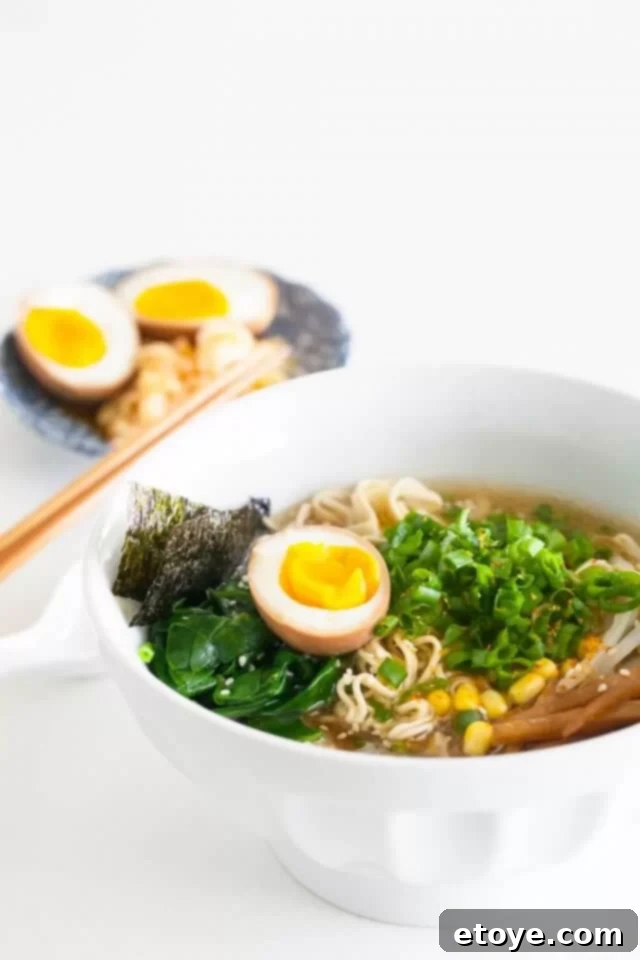
Crafting Your Ramen Broth: Two Flavorful Master Approaches
To fully demonstrate the remarkable versatility and profound depth of flavor achievable with an Instant Pot, we will meticulously explore two distinct yet equally rewarding methods for preparing your essential ramen broth. Each approach, while unique, consistently yields a rich, clean, and deeply satisfying soup base that forms the heart of your homemade ramen.
Batch 1: Embracing the Traditional Richness of Pork Hock and Chicken Wings

Pork hock, a cut highly esteemed in many culinary traditions, particularly Asian cuisine, is celebrated for its exceptionally high collagen content. This collagen, when subjected to proper cooking, renders down into a luxuriously thick and profoundly gelatinous broth – a hallmark of premium ramen. I typically source my pork hock from well-stocked Chinese or Vietnamese grocery stores, where it is often sold frozen and conveniently pre-cut into sections. These cuts expose the bone and cartilage, which is absolutely ideal for maximizing flavor extraction. After a simple defrosting, these sections are perfectly prepared for the initial steps. To further amplify the collagen content and introduce a complementary poultry depth, we will also incorporate chicken wings into this batch.
The Essential Parboiling Step: The Secret to a Pristine Broth
Regardless of whether you choose to use pork hock or spareribs as your primary bone base, a critically important initial step for achieving any truly clean, clear, and flavorful ramen broth is the parboiling of the bones. This meticulous process, often referred to as a “harsh boil,” is highly effective in cleansing the bones, purging them of impurities, congealed blood, and surface proteins that would otherwise inevitably cloud your broth and introduce an undesirable “scummy” or muddled taste. This fundamental technique is widely employed by seasoned chefs when preparing bones for dishes like Vietnamese pho or other long-simmered stocks, ensuring a pristine end product.

To execute this vital parboiling step, place the pork hock and chicken wings into a spacious stockpot, cover them generously with cold water, and bring the water to a rapid, vigorous, rolling boil. Allow the bones to cook at this hard boil for approximately 5-8 minutes. During this period, you will observe a substantial amount of grayish foam, coagulated blood, tiny bone particles (inevitable when bones are sawed), and various surface proteins rising to the water’s surface. This is precisely the undesirable matter we aim to eliminate! Following the designated boiling time, carefully drain and entirely discard this scummy water. Then, thoroughly rinse both the bones and the interior of the pot under cool running water, ensuring all clinging residue is completely removed. There’s no need to fret about “losing any flavor” – this initial, decisive purge exclusively removes impurities, thereby setting the perfect stage for a truly clean, exceptionally pure, and deeply flavorful broth to develop.

It is imperative to perform this parboiling step on the stovetop, rather than directly within your electric pressure cooker. Electric pressure cookers are generally designed for sealed, pressurized cooking and typically do not generate or sustain the high, rolling boil temperatures required for this vigorous scrubbing action that effectively extracts and purges impurities from the bones. As visually demonstrated in the image above, a strong, unhindered boil is the absolute key to the efficacy of this critical cleaning process.
Once the bones have been meticulously parboiled and thoroughly rinsed, they are carefully transferred into the clean pressure cooker pot. For this initial batch, our primary culinary objective is to achieve a clean, classic ramen broth, characterized by a pronounced meaty flavor. We will introduce a judicious touch of garlic and ginger, specifically chosen to complement and enhance the natural richness of the pork and chicken, allowing the inherent flavors of the bones to truly shine and take center stage. I have confidently utilized my reliable Fagor Electric Pressure Cooker for this method, always striving for a broth of unparalleled purity and profound depth.
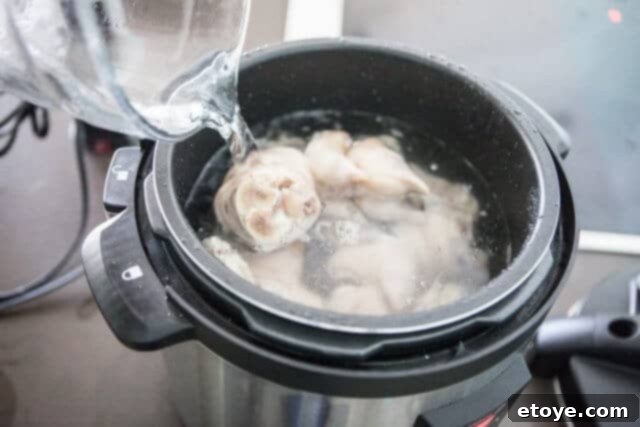
Batch 2: Sparerib Bones with Caramelized Onion for a Deeper, More Aromatic Ramen Broth
For those who seek an equally robust yet perhaps more readily accessible option, pork spareribs present an excellent and highly recommended choice for building your ramen broth. They are conveniently and widely available in most grocery stores and contain a substantial amount of both cartilage and bone, components that are absolutely essential for developing that coveted, desirable gelatinous mouthfeel. In this second batch, we take the flavor profile to an even higher plane with the strategic addition of deeply caramelized onions. This enhancement results in a broth that is not only rich in body but also intensely aromatic, possessing a visually darker and more complex character.

When selecting your pork spareribs for this recipe, a crucial step to maximize flavor extraction is to ask your butcher to make several cross-cuts with their saw. This simple yet highly effective request significantly exposes more of the precious bone marrow and collagen-rich cartilage. The greater the surface area exposed, the more collagen will dissolve into your broth during the pressure cooking process, thereby creating that signature rich, thick, and incredibly satisfying consistency that defines an exceptional ramen broth.

Mirroring the first batch, chicken wings are strategically incorporated into this sparerib broth. They are chosen specifically for their excellent collagen-rich properties, serving as an ideal and easily obtainable complement to the pork. Chicken wings consistently provide beneficial effects similar to chicken feet, which can often be more challenging for many home cooks to source.
The Flavor Secret Weapon: Deeply Caramelized Onions
Before introducing the parboiled bones, this batch incorporates a truly transformative flavor enhancer: deeply caramelized onions. The Instant Pot’s integrated “Sauté” function is perfectly designed and incredibly well-suited for this crucial task. Begin by heating a small amount of neutral cooking oil in the inner pot, then add your thick-sliced onions. The absolute key to success here is patience. Allow the onions to cook down slowly and gently, stirring only occasionally, until they achieve a profound, rich brown color. This meticulous process of caramelization develops complex sugars and deep, savory Maillard reaction notes, fundamentally transforming the simple onion into an ingredient that will infuse your broth with an incredible depth of flavor, a stunning darker hue, and an intensely more aromatic quality that elevates the entire dish.

It is paramount to ensure that the onions are deeply browned but under no circumstances allowed to burn, as burnt onions will unfortunately impart an undesirable bitter taste to your precious broth. Once the onions have reached their perfect caramelized state, add the smashed garlic, a generous thumb-sized nub of ginger, and the thoroughly parboiled and rinsed spareribs and chicken wings to the pot. Carefully fill the pot with water, making sure it reaches precisely the “MAX” line indicated on your pressure cooker’s inner pot, ensuring all ingredients are adequately submerged. This meticulous and thoughtful preparation lays the groundwork for creating a truly superior and unforgettable ramen broth.
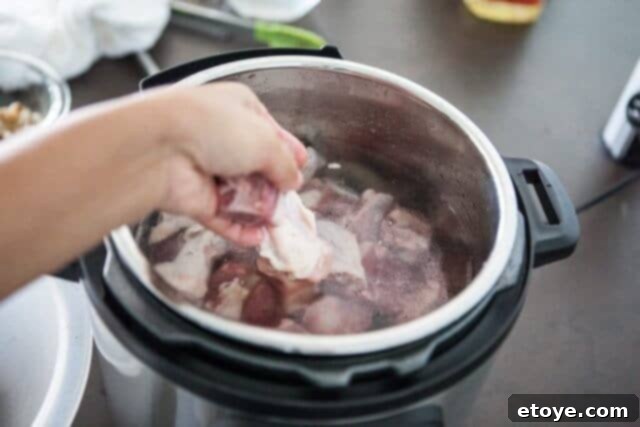
The Pressure Cooking Process: Unlocking Profound Flavors Efficiently
With your ingredients meticulously prepped and carefully layered within the pressure cooker, it’s time to entrust the final, transformative stage to the power of modern kitchen technology. Both batches of broth – whether crafted with pork hock or with spareribs and caramelized onions – will undergo an identical pressure cooking duration. Set your electric pressure cooker (be it an Instant Pot or a Fagor, which I’ve utilized for comparative testing) to cook on high pressure for a robust and essential 90 minutes. This extended pressure cooking time is absolutely critical; it efficiently breaks down the tough collagen inherent in the bones and expertly extracts all those deeply savory, umami-rich flavors, thereby transforming simple, raw ingredients into a complex, profoundly aromatic, and incredibly rich broth that forms the very foundation of your ramen.
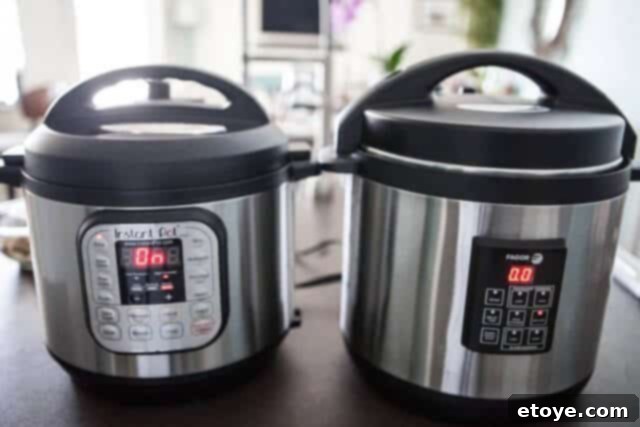
Once the 90-minute high-pressure cooking cycle has gracefully completed, you are presented with two distinct options for pressure release: a natural pressure release (NPR) or a manual (quick) pressure release (QR). Natural pressure release allows the internal pressure to dissipate slowly and gradually over time. This method can sometimes result in slightly more tender meat and less turbulence within the broth, potentially yielding a clearer end product. For a manual quick release, you will carefully turn the steam release valve. It is of utmost importance to always utilize a pair of long-handled tongs and a thick kitchen towel to protect your hands and arms from the intense, hot steam and any potential splattering liquid. Prioritizing safety is paramount in this step!

Comparing the Results: Pork Hock Broth vs. Spareribs & Onion Broth
After the pressure has fully and safely released, it’s a moment of eager anticipation as you unveil your proudly homemade ramen broths. Carefully open the lid, and you will be immediately greeted by a wonderfully aromatic steam, promising the deliciousness to come. The next crucial step involves straining the broth to meticulously separate the liquid gold from the cooked bones and aromatic solids. A fine-mesh strainer is the ideal tool for this task, ensuring a beautifully clear and smooth consistency in your final broth. If your preference leans towards a less oily broth, this is also the opportune moment to judiciously skim any excess surface oils using a ladle or a dedicated fat separator before chilling. Now, let’s carefully examine and compare how the two distinct approaches measured up.
Batch #1 Results: The Pure Essence of Pork Hock and Chicken Wings Broth

The broth meticulously crafted from the pork hock and chicken wings batch presented itself as beautifully clean and remarkably clear, exhibiting a delicate, inviting golden hue. It possessed a full, rich, and deeply meaty flavor that unequivocally spoke of its traditional, unadulterated roots. However, in terms of texture, it offered a discernibly thinner consistency when compared directly to the spareribs batch, characterized by a more delicate and refined mouthfeel. This particular broth stands as an excellent choice for connoisseurs who profoundly appreciate a classic, pure, and unadulterated pork flavor to be the primary, starring note in their ramen. It will certainly require careful seasoning with either salt or soy sauce to taste, thereby expertly drawing out its inherent, profound savoriness to perfection.
Batch #2 Results: The Enhanced Depth of Spareribs, Chicken Wings, and Caramelized Onion Broth
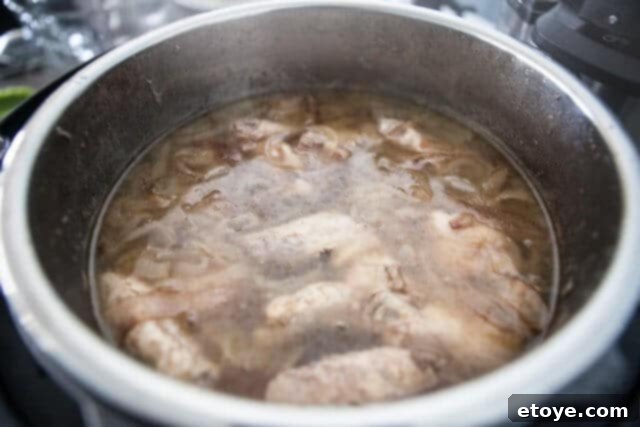
In stark, yet equally appealing, contrast, the broth from the spareribs and caramelized onion batch yielded a distinctly different and profoundly richer result. Its color was a noticeably deeper, alluring brown, a direct testament to the transformative caramelization of the onions. This broth was also noticeably richer and boasted a thicker, more luxurious consistency. The aroma emanating from this batch was considerably more complex and intensely fragrant, with the sweet and savory notes derived from the caramelized onions beautifully complementing and enriching the robust, meaty base. This particular broth offered a more “complete” and nuanced flavor profile, accompanied by a luscious mouthfeel that was wonderfully satisfying and deeply comforting. It is unequivocally perfect for those who truly savor a broth imbued with extra layers of umami complexity and a slightly more pronounced body.
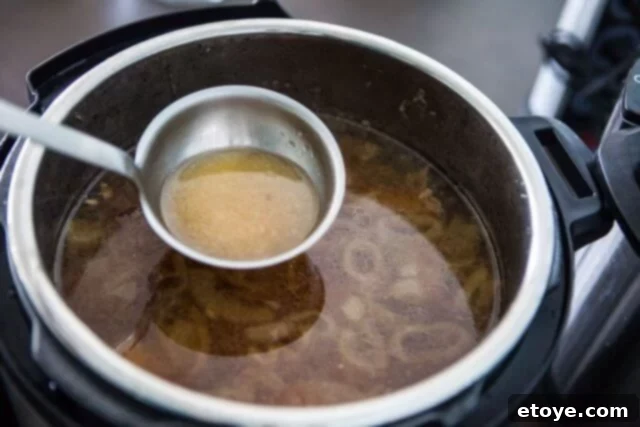
Observe the compelling visual contrast in the images below: after careful straining, the two ramen broths are presented side-by-side, vividly showcasing the remarkable differences in their clarity and depth of color. Both are undeniably beautiful in their own right, yet they unequivocally offer distinct sensory experiences for the discerning palate.
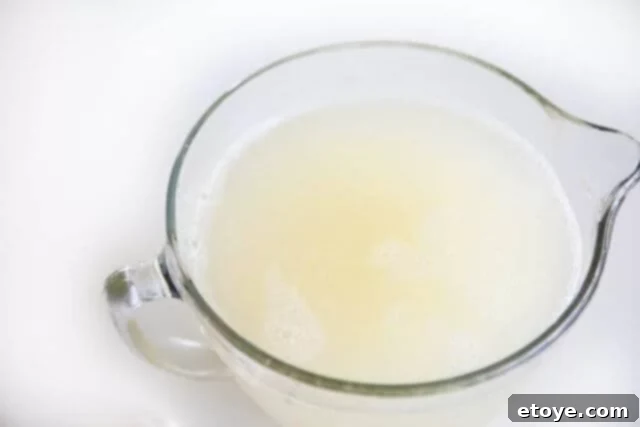


The Gelatin Test: The Unmistakable Sign of a Superior Ramen Broth
A truly unequivocal indicator of a high-quality, collagen-rich broth is its remarkable texture after it has been allowed to fully refrigerate. Once thoroughly chilled, a meticulously made ramen broth should transform into a remarkably gelatinous consistency, almost akin to a savory jello. This firm, wobbly, and spoon-standing consistency is a direct result of the collagen, meticulously extracted from the bones, breaking down into gelatin during the prolonged and intensive cooking process. If your spoon can practically stand upright when inserted into the chilled broth, you have achieved resounding success in extracting that coveted body and profound richness! This glorious gelatinous texture, when gracefully reheated, magically melts back into a wonderfully full and incredibly satisfying liquid, imbuing your soup with a truly luxurious and silken quality that elevates the entire dining experience.

Take note of the very thin, almost imperceptible layer of fat that settles on top after the chilling and skimming process. This is precisely the delicate balance we strive for – just enough fat to contribute vital flavor and a luxurious mouthfeel, but not so much that it creates an overly oily or greasy sensation that can overwhelm the palate. My personal preference consistently leans towards a smoother, cleaner, and more elegant soup experience, and this thoughtfully refined method consistently delivers precisely that.

Mastering Soy Sauce Eggs (Ajitama): The Essential Ramen Topping
No bowl of ramen, especially a meticulously prepared one, is truly complete without the addition of perfectly crafted ajitama – those beautifully marinated, soft-boiled eggs featuring a rich, custardy yolk that is both creamy and firm. These exquisite eggs contribute a crucial layer of umami, a subtle sweetness, and a delightful textural contrast to your ramen, elevating it from good to truly exceptional. The best part? Despite their gourmet appearance, they are incredibly simple to make right in your own kitchen!
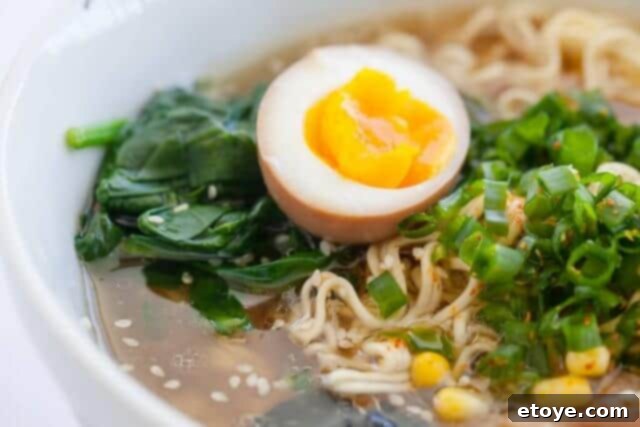
The quintessential ajitama is characterized by a yolk that achieves a perfect state of softness and creaminess – it should not be runny, yet it must be far from the dry, powdery texture often associated with a hard-boiled egg. It occupies a delightful sweet spot, often affectionately referred to as “soft+boiled,” offering an irresistible texture that enhances every bite of ramen.
How to Prepare Your Perfect Ajitama (Marinated Soft-Boiled Eggs)
- Boil the Eggs Precisely: Gently place 3-6 large eggs into a small to medium-sized pot. Cover the eggs with cold water by approximately one inch. Bring the water to a rapid, rolling boil over high heat. As soon as the water reaches a full, vigorous boil, immediately remove the pot from the heat, cover it tightly with a lid, and let the eggs sit undisturbed for precisely 6 and a half minutes. This precise timing is absolutely key to achieving that coveted custardy yolk and firm, yet tender, whites.
- Prepare the Flavorful Marinade: While your eggs are gently cooking, in a tall, skinny container (such as a Pyrex measuring cup or a clean quart-sized sealable bag), whisk together 1/2 cup of low-sodium soy sauce, 1/4 cup of water, and 1 1/2 tablespoons of granulated sugar until the sugar is fully dissolved. The tall container is ideal as it ensures the eggs are fully submerged with a minimal amount of liquid.
- Rapid Cooling and Gentle Peeling: Immediately after the 6.5 minutes are up, transfer the eggs to an ice bath or rinse them thoroughly under cool running water. This crucial step immediately halts the cooking process, preventing overcooking, and also aids significantly in easier peeling. Once the eggs have cooled sufficiently, carefully peel them under running water for best results.
- Marinate for Maximum Flavor: Place the whole, peeled eggs into the prepared sweet soy sauce marinade. Allow them to marinate for a minimum of 2 hours in the refrigerator, or for an even more profound flavor absorption, ideally marinate them overnight.
- Serve with Elegance: When you are ready to assemble and enjoy your ramen, carefully remove the eggs from the marinade (be sure to reserve the versatile sweet soy sauce for other culinary uses!). Using a sharp knife, slice each egg cleanly in half lengthwise and arrange them artfully on top of your steaming bowl of ramen, adding both visual appeal and a burst of flavor.

Expert Tip for Exceptionally Easy Egg Peeling
For those fortunate enough to use exceptionally fresh eggs, which are notoriously challenging to peel when boiled traditionally, consider a game-changing technique: steaming your eggs. Utilizing a microwave egg cooker designed for steaming, or even a stovetop steaming basket, creates a tiny, critical layer of air between the shell and the egg white. This phenomenon renders the eggs incredibly easy to peel, often without a single struggle. This method is particularly invaluable if you have backyard hens producing very fresh eggs, as it’s a well-known fact that older eggs naturally become easier to peel due to moisture evaporation creating more space between the shell and the cooked white.
Creative and Economical Uses for Your Leftover Sweet Soy Sauce Marinade
Absolutely do not discard that intensely flavorful marinade after your eggs are done! It is an incredibly versatile condiment that can be ingeniously reused and repurposed in numerous delicious ways, adding a burst of umami and sweetness to many dishes:
- Another Batch of Eggs: Its most obvious and satisfying reuse is for marinating another fresh batch of soft-boiled eggs, ensuring minimal waste and continued delight.
- Dumpling Dipping Sauce: Transform it into a superb dipping sauce for your favorite dumplings. For an extra kick, I particularly enjoy adding a spoonful of vibrant chile garlic sauce to it.
- Stir-Fry Flavor Boost: Incorporate a couple of spoonfuls into your stir-fries during the final stages of cooking for an instant infusion of savory-sweet depth and gloss.
- Quick Noodle Side Dish: Toss it with freshly cooked noodles and thinly sliced scallions for an incredibly quick, flavorful, and satisfying side dish or light meal.
- Steamed Vegetable Drizzle: Lightly drizzle it over steamed or blanched vegetables, transforming simple greens into an umami-rich and delectable accompaniment.
- Ramen Broth Enhancer: If your palate appreciates a slightly sweeter and more complex broth, a small addition to season your ramen broth can subtly deepen its flavor profile.
Pork Hock vs. Spareribs: The Decisive Verdict for Your Ramen Broth
Our meticulous side-by-side comparison unequivocally highlights the distinct and compelling advantages of utilizing pork spareribs in conjunction with deeply caramelized onions for your ramen broth. While both preparation methods undeniably yield a deeply gelatinous and profoundly flavorful broth (a quality proudly evidenced by their firm, jello-like consistency after careful refrigeration), the sparerib and caramelized onion batch truly distinguished itself and shone brightest. The strategic browning of the onions made a monumental difference, contributing not merely to a darker, more visually appealing color, but, more importantly, to an incredibly richer, thicker, and far more complete and nuanced flavor profile that truly elevates the entire bowl.
Furthermore, pork spareribs offer a significant advantage in terms of accessibility; they are considerably easier to locate and purchase in most mainstream grocery stores compared to the more specialized pork hock, making this an ideal and highly convenient option for enthusiastic home cooks everywhere. Despite their wider availability, spareribs consistently produce an impressive amount of gelatin and a robust, full-bodied flavor, perfectly mimicking the highly sought-after qualities often found in the most traditional tonkotsu broths.
Therefore, I wholeheartedly and confidently recommend opting for pork spareribs over pork hock when embarking on your Instant Pot Ramen journey. Crucially, remember to explicitly ask your butcher to cross-cut the ribs; this simple yet vital request dramatically increases the exposed bone and collagen, ensuring the maximum possible extraction of body and flavor into your precious broth.
Finally, when it comes to the critical step of seasoning your finished broth, I personally find that soy sauce provides a more nuanced depth and complexity compared to simple salt alone – but the ultimate choice, of course, is entirely yours. Adjust the seasoning precisely to your desired level of savory perfection, creating a broth that is uniquely your own.
Instant Pot Ramen: Reimagining a Japanese Classic for the Modern Kitchen
Traditional Japanese tonkotsu (pork bone) ramen broth is justly revered globally for its signature milky, immensely rich, and often fatty consistency, a profound depth of flavor painstakingly achieved through countless hours of dedicated, slow simmering. Our innovative Instant Pot Ramen recipe elegantly streamlines and simplifies this intricate, time-consuming process without sacrificing even a single ounce of that authentic, profound flavor profile. By intelligently harnessing the incredible power and efficiency of the electric pressure cooker and adeptly utilizing readily available, everyday ingredients, we bring this once-complex culinary masterpiece into the realm of practical, enjoyable, and accessible everyday home cooking.
While my appreciation for the robust, unapologetically rich flavors of traditional pork-based ramen runs deep, I sometimes find the intensely fatty mouthfeel of very traditional tonkotsu to be a bit overwhelming for my personal palate. This thoughtfully crafted recipe prioritizes delivering a more delicate and refined texture – a broth that is noticeably less fatty, yet simultaneously retains an incredibly full-bodied and satisfying flavor profile that you can savor from the very first spoonful to the very last, without ever feeling overly heavy or satiated. This balanced approach ensures a wonderfully satisfying and deeply enjoyable ramen experience that is both remarkably authentic in taste and considerably more approachable for varying palates and dietary preferences.
Our comprehensive culinary exploration thoughtfully features these two distinct recipes and techniques for crafting your Japanese Ramen Noodle Soup: one embracing the traditional, yet often harder to find, pork hock, and the other leveraging the more accessible and equally effective pork spareribs, offering versatility and exceptional results.
The Unrivaled Power of Spareribs in Instant Pot Tonkotsu-Style Ramen
Many time-honored classic tonkotsu broth recipes specifically call for a combination of collagen-rich ingredients such as chicken feet, chicken wings, and either pork hock or various cuts of pork feet and legs. These components are meticulously chopped or sectioned to expose as much cartilage and bone as humanly possible. This intricate preparation is the long-held secret behind tonkotsu’s signature creamy, incredibly rich, and luxuriously thick broth: the prolonged, gentle simmering process expertly breaks down the tough collagen present in these components, gracefully releasing precious, flavor-imparting gelatin. However, sourcing unsmoked pork hock, particularly outside of specialized Asian supermarkets, can often present a significant challenge for many home cooks.
Our simpler, yet undeniably effective, Instant Pot tonkotsu-style ramen broth brilliantly sidesteps this potential sourcing issue by ingeniously utilizing readily available pork spareribs. When meticulously prepared (specifically, cut crosswise to maximize the exposure of bone and cartilage), spareribs consistently deliver comparable amounts of vital collagen and profound flavor. This smart substitution makes achieving an authentic-tasting, beautifully gelatinous broth a practical and utterly delightful reality for every home chef.
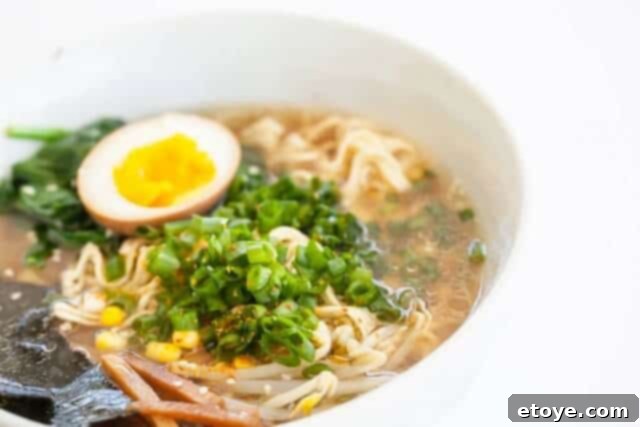
Harnessing the Instant Pot for Ramen Perfection: A Modern Culinary Marvel
The electric pressure cooker, exemplified by popular models like the Instant Pot, has undeniably emerged as an invaluable and transformative tool for modern home cooks, and my personal adoration for its capabilities knows no bounds! Instead of committing a full six or more laborious hours to diligently supervising a simmering pot of broth on the stovetop, the Instant Pot miraculously allows us to achieve profoundly deep, complex, and intensely savory flavors in a mere 90 minutes. This dramatic and welcome reduction in cooking time is nothing short of a game-changer for the realm of homemade ramen, making it accessible even on busy schedules.
I have personally conducted extensive side-by-side testing of the Instant Pot alongside my trusted Fagor electric pressure cooker, and both appliances consistently deliver outstanding, professional-grade results. Their remarkable multi-functionality and generous cooking capacities are perfectly suited and ideally proportioned for preparing substantial batches of incredibly flavorful ramen noodle soup, making them perfect for cherished family meals or efficient meal prepping throughout the week. Truly, investing in a high-quality pressure cooker unequivocally unlocks a vast and exciting world of culinary possibilities, transforming ambitious recipes into achievable delights.
Elevate Your Bowl: The Ultimate Guide to Essential Ramen Toppings
A truly exceptional bowl of ramen transcends mere broth and noodles; it transforms into a vibrant canvas for an exquisite array of flavorful and textural toppings. These additions are not just for aesthetics; they infuse the dish with extra dimensions of taste, delightful contrasts in texture, and a burst of inviting color. Never hesitate to customize your ramen bowl to precisely match your personal preferences and creative inclinations!
- Finely Minced Green Onions (Scallions): A timeless and universally adored classic topping, offering a crisp, fresh, and slightly pungent bite that beautifully cuts through the richness of the broth, alongside a delightful splash of vibrant green.
- Fresh Bean Sprouts: For an invigorating and refreshing crunch that provides a wonderful textural contrast to the soft, yielding noodles and the deep, rich broth.
- Cooked Bamboo Shoots (Menma): Canned bamboo shoots are a perfectly acceptable and highly convenient option. To dramatically elevate their flavor, I enthusiastically recommend marinating them in the reserved sweet soy sauce from your ajitama eggs (you can even marinate them simultaneously with the eggs for efficiency!). This simple step imbues them with a complex savory-sweet depth that enhances their natural flavor.
- Blanched Spinach: A swift dip in boiling water for fresh spinach, or simply defrosting frozen spinach, is all that’s needed. Always remember to meticulously squeeze out as much excess water as possible from the spinach to prevent any undesirable dilution of your beautifully crafted broth.
- Toasted Sesame Seeds: These tiny powerhouses add a subtle, nutty flavor and a pleasing visual appeal, enhancing the overall sensory experience.
- Nori (Dried Seaweed): Crisp, thin sheets of nori provide an unmistakable oceanic umami boost and a unique, delicate texture that melts slightly into the warm soup.
- Shichimi Togarashi (Japanese 7-Spice Blend): An absolutely fantastic and versatile condiment to introduce a spicy, aromatic kick to your ramen. This traditional Japanese blend typically comprises red chili pepper, aromatic orange peel, toasted sesame seeds, Japanese pepper (sansho), warming ginger, and a touch of seaweed. Fun fact: it’s also my secret ingredient for crafting truly incredible scrambled eggs!
- A Tiny Drizzle of Asian Sesame Oil: Exercise caution and restraint here, as a little goes an incredibly long way. Too much sesame oil can easily overpower the delicate, intricate balance of flavors in your meticulously prepared broth.
- My Personal Secret Tip: Chinese Preserved Bamboo Shoots in Chile Oil: For an adventurous and explosive extra layer of bold, spicy, and wonderfully fermented goodness, a generous spoonful of these can unequivocally elevate your ramen experience to an entirely new, thrilling dimension. Don’t tell anyone!

The Irreplaceable Star of the Show: Ramen Noodles
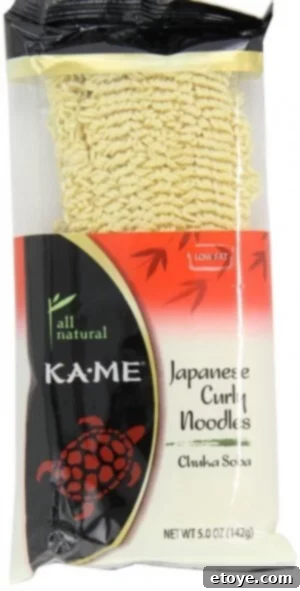
While the broth is undeniably the soulful foundation, the noodles are unequivocally the vibrant heart of any truly great ramen. For the captivating photos featured throughout this recipe, I’ve meticulously used high-quality dried Japanese ramen noodles. It is absolutely crucial to consciously select dried, non-fried noodles – actively avoid the inexpensive, typically fried instant ramen packets that often come with powdered seasoning. Instead, seek out either fresh or premium dried ramen noodles specifically engineered and designed for hot soup; their superior texture, delightful chewiness, and remarkable ability to absorb the rich broth are far, far superior to their instant counterparts.
For those eager and ambitious enough to embark on the ultimate ramen journey, the incredibly rewarding experience of making your own fresh ramen noodles from scratch is an endeavor worth pursuing. We’ve been tirelessly experimenting with various homemade ramen noodle recipes for several months now, and once fully perfected, we will be absolutely thrilled to share our definitive findings with you. A Philips Noodle Maker has, in fact, rapidly become an indispensable and cherished tool in our kitchen for this precise endeavor. Its remarkable ease of use and impressive capability to consistently produce fresh pasta and noodles in a delightful variety of shapes has transformed noodle-making from a daunting task into a joyous and effortlessly satisfying culinary art.
If you’re feeling inspired and ready to dive headfirst into the world of handmade noodles right away, the insightful blog “Not So Ancient Chinese Secrets” offers a fantastic and comprehensive homemade ramen noodle recipe from scratch. They also wholeheartedly endorse the efficiency and quality of the Philips Noodle Maker for achieving consistently perfect results. Truly, fresh noodles possess the unparalleled ability to elevate your homemade ramen to an entirely new, sublime level, providing an unparalleled bouncy texture and an incredibly fresh, authentic flavor that simply cannot be replicated.
Expand Your Ramen Repertoire: More Culinary Adventures Await
If you’ve thoroughly enjoyed crafting and savoring this Instant Pot Ramen recipe, you’ll be delighted to discover that there’s an expansive and exciting world of ramen variations waiting to be explored! Dive into these other delicious recipes and incredibly helpful tips to further broaden your ramen-making skills and tantalize your taste buds with new flavors:
- Steamy Kitchen Miso Ramen: Indulge in a profoundly savory and deeply comforting bowl, enriched with the distinctive umami of fermented soybean paste.
- Easy Beef Ramen Noodle Bowl: A quick, robust, and incredibly hearty option, tailor-made for devoted beef lovers seeking a satisfying meal.
- 15 Minute Miso Ramen Recipe: The ultimate solution for those moments when you crave the deep flavors of miso ramen but need a delicious bowl ready in a flash.
- Kimchi Ramen Recipe: Ignite your palate with a vibrant, boldly spicy, and exhilarating twist, offering an exciting and unforgettable flavor profile.
- 30 Ramen Hacks: Unlock a treasure trove of creative tips, ingenious tricks, and clever shortcuts designed to effortlessly elevate any ramen bowl to gourmet status.
Have you had the pleasure of trying your hand at making this Instant Pot Ramen at home? We are incredibly eager to hear all about your culinary experience! Please feel free to leave a star rating below and graciously share your thoughts, any personal tips, or your favorite delightful variations in the comments section. Happy cooking, and may your ramen bowls always be brimming with flavor!

Pressure Cooker Ramen Recipe
Jaden Hair
Pin Recipe
Ingredients
- 2 1/2 pounds pork spareribs cut into 2″ pieces
- 1 1/2 pounds chicken wings
- 2 tablespoons cooking oil
- 2 large onions peeled, thick sliced
- 3 cloves garlic smashed
- thumb-sized nub of ginger
- soy sauce or salt to taste
Instructions
- Bring a large stockpot filled with water to a boil. (If your electric pressure cooker pot is stovetop-safe, feel free to use that instead of dirtying another pot.) Add in the ribs and the wings. Return to a rolling boil and let cook for 5-8 minutes on high heat. Drain and discard the water. Rinse the ribs and wings thoroughly with clean water, ensuring all scum clinging to the meat is removed. This parboiling step is crucial for a clean broth.
- Following your electric pressure cooker’s manufacturer’s directions, select the “Sauté” or “Brown” function on high heat. Swirl in the cooking oil and add the thick-sliced onions. Sauté the onions for approximately 8 minutes, or until they are deeply caramelized and a rich brown color. Be patient during this step, as proper caramelization greatly enhances the broth’s flavor.
- Add the smashed garlic and ginger to the pot, stirring briefly until fragrant (about 30 seconds). Then, add the parboiled and rinsed ribs and wings. Fill the pot with water up to the “MAX” line indicated on your pressure cooker. Close the lid, ensure the steam release valve is sealed, and set to cook on high pressure for 90 minutes.
- After the cooking cycle is complete, you can either allow the pressure to release naturally (NPR) or perform a manual quick release (QR). If using QR, always use a kitchen towel and tongs to carefully turn the steam release valve, protecting yourself from hot splatters and steam.
- Once the pressure has fully released, carefully open the lid. Strain the broth through a fine-mesh strainer, discarding the solids (bones, onions, ginger, garlic). If you prefer a less oily broth, skim any surface oils using a ladle or fat separator. Taste the broth and season with soy sauce or salt to your preference. Your rich ramen broth is now ready to be enjoyed!
